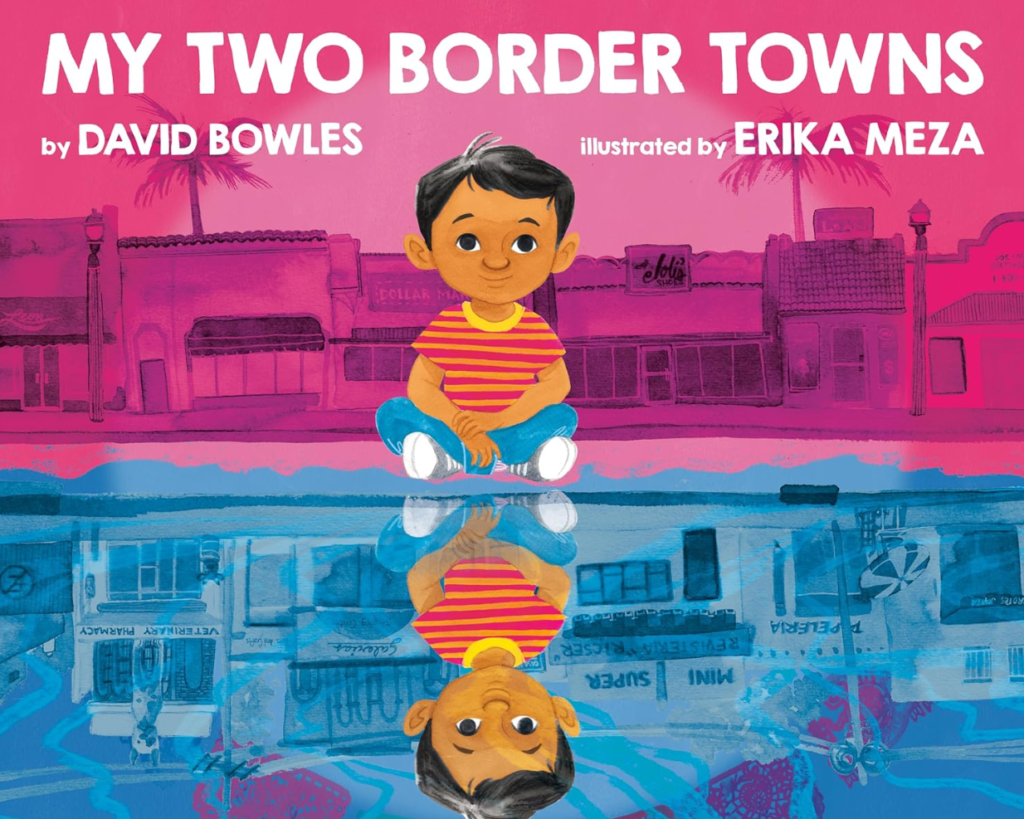
Read-aloud Rating
How do the details in a story help us understand its main idea?
Age Range: 7 to 9
Activity Focus: Practicing using details to determine the main idea of a story
Objective: Children will identify key details from the story to determine its main idea and understand the importance of community care and cultural connections.
Materials:
- My Two Border Towns by David Bowles
- Chart paper or whiteboard
- Markers
- Graphic organizer for identifying details and main ideas
- Sticky notes
Question Before Reading:
- What do you think the title My Two Border Towns means?
- Have you ever visited two places that felt connected in some way? What made them feel similar or different?
- Why do you think people sometimes bring supplies or help others in their community?
Explain that the story explores a boy’s weekend trips to a town across the border and how he and his father connect with their community.
Read Aloud:
During the read-aloud, ask these guided questions to engage children:
- Page showing the statue of the eagle: “Why do you think this statue is important to the boy and his father?”
- Scene at the restaurant: “What details here show us how the boy feels about this place?”
- Scene with the asylum seekers: “Why do you think the father and son bring supplies to their friends? What does this tell us about their values?”
Encourage children to use sticky notes to jot down details they notice about the places and people in the story.
Discussion:
After the read-aloud, discuss the following:
- What are some of the most important places the boy visits on his trip? Why are they meaningful to him?
- How do the boy and his father show that they care for their community?
- What do you think is the main idea of the story? What details helped you figure it out?
Activity:
Sticky Notes Collaborative Game
Preparation:
- During the read-aloud, children will jot down details from the story on sticky notes (e.g., “They bring supplies to asylum seekers,” “They eat at their favorite restaurant,” “They visit Tío Mateo at the jewelry store”).
- Provide a large chart or whiteboard with two labeled sections: “Key Details” and “Not Key Details.”
- Have a space titled “Main Idea Statement” for summarizing the story’s main idea.
How to Play:
- After the read-aloud, collect all the sticky notes and shuffle them to create a “detail pile.”
- Divide children into small groups and distribute a portion of the sticky notes to each group.
- Each group reviews their sticky notes and decides which details are most important for understanding the story and which are less important.
Sorting the Details:
- Groups take turns adding their “important” sticky notes to the “Key Details” section of the chart and their “not key” sticky notes to the “Not Key Details” section, explaining their choices.
- Discuss the chart as a class, revisiting any sticky notes that might be misplaced and refining the lists together.
Finding the Main Idea:
- Using the “Key Details” section, guide the class to craft a one-sentence main idea for the story. For example: “The story shows how a boy and his father care for their community by visiting meaningful places and helping others.”
Reflection:
- Ask children how their sticky notes helped them focus on the important parts of the story.
- Discuss how sorting details makes it easier to understand the main idea.
Extension:
Main Idea Digital Collage
Set Up:
- Provide access to a digital collage-making tool such as Canva, Google Slides, or Padlet.
- Preload images and icons related to the story, such as a truck, an eagle statue, a paletero cart, supplies, or scenes from a border town, or encourage children to find appropriate royalty-free images.
Creating the Collage:
- Ask children to create a new digital canvas.
- They will drag and drop images, symbols, and text boxes onto their collage. Encourage them to think critically about which elements best represent the story’s main idea.
- Include text boxes for key words or short phrases from the story (e.g., “asylum seekers,” “community care,” “border bridge”).
Adding Explanations:
- Using a comment feature or a slide note section (depending on the tool), have children explain how each image or word they included connects to the main idea.
- Example: “I included a picture of supplies because the boy and his father deliver these to asylum seekers, showing their care for the community.”
Sharing and Reflection:
- Host a virtual gallery walk by sharing the digital collages in a shared folder.
- Each child presents their collage and explains how their chosen elements highlight the main idea and the supporting details.
Tags:
- Age Range: 7 to 9
- Competencies: Critical Thinking, Empathy, Community Building, Cultural Understanding, Media/Information/Digital Literacy, Creativity and Innovation, Communication
- Type of Activity: Art Activity, Concept Mapping, Digital Creation, Storytelling and Presentation
- Content Areas: ELA, Social Studies, Art, Technology/Computer Science
- Calendar: National Hispanic Heritage Month, World Refugee Day, International Day of Friendship